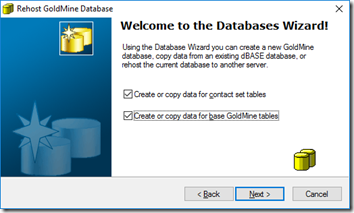Today I moved my GoldMine databases from a SQL 2012 Express instance on one server to a SQL 2016 Standard instance on another server. I wanted to jot down a few notes. This is not a detailed procedure, but if you are familiar with SQL and GoldMine, you may find it useful. I’m currently on GoldMine 2017.1.0.377.
Big Tip Move one database at a time while you are still logged in to another database on the old server. You can only edit database aliases while logged in to GoldMine, and you can only log in to GoldMine if you can open a database. So open a dummy databases and work on your other databases.
1. In GoldMine, open a dummy or test database (create one if necessary) on your old server. This databases should include contact set tables and base GoldMine tables. (Tools > Databases > Open Databases or New Database)
2. Use SQL Management Studio to detach one of your main databases from the old server and attach it to the new SQL server. In the database’s Security > Users section, make sure you see the SQL user that GoldMine uses (e.g. “goldmine”). Add that user if it’s missing.
3. Back in GoldMine, go to Tools > Databases > Alias Manager. Edit the alias for the database you just moved. You should only have to change the host. Test the connection. This turned out to be what I had missed—I needed to set up the SQL Browser and firewall rules as explained in this article: Connect to SQL Server 2012 Express Over the Network. Note that although that was written about SQL 2012 Express, most of it applies to SQL 2016 Standard as well.
4. Repeat steps 2 and 3 for any other databases you have.
5. Finally, in GoldMine, open one of your main databases, then repeat steps 2 and 3 to move your dummy/test database.
Note One strange thing I experienced was that GoldMine crashed the first time I opened a database from the new server. But when I re-opened GoldMine, it seemed to work fine, and I could open the databases again without crashing.

